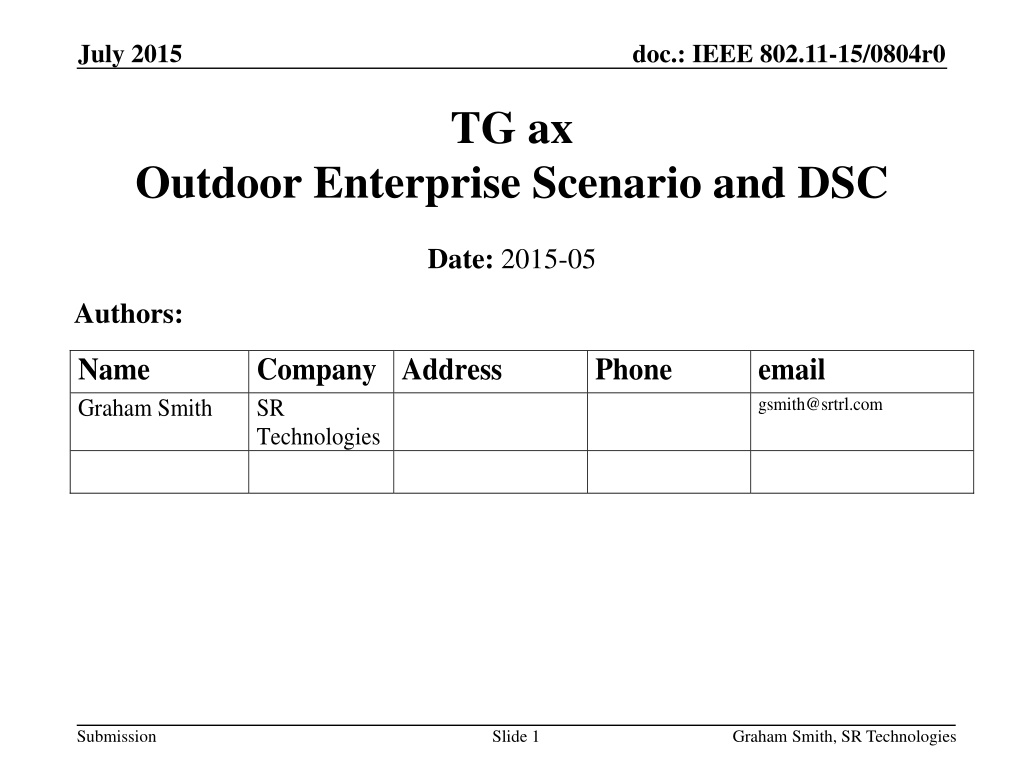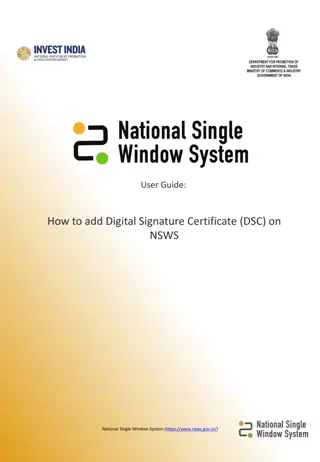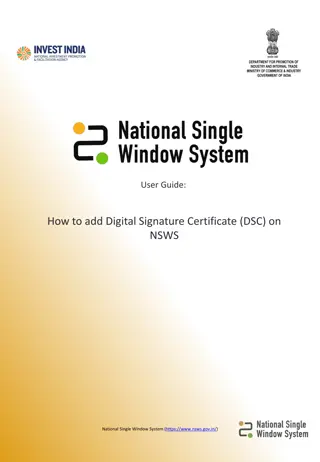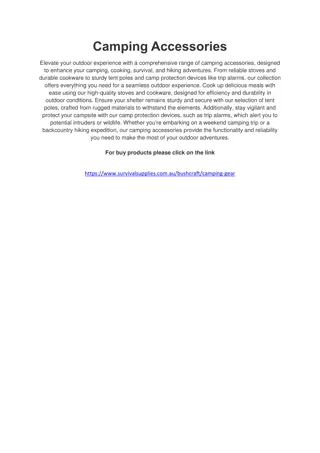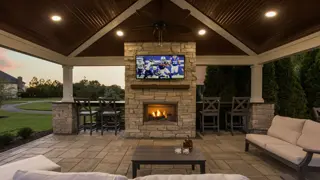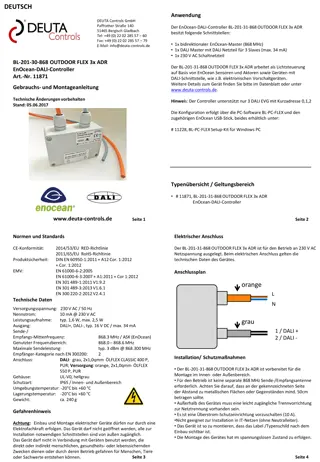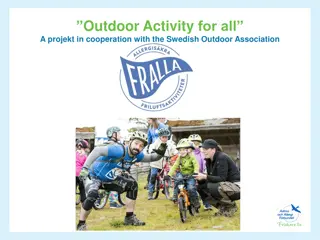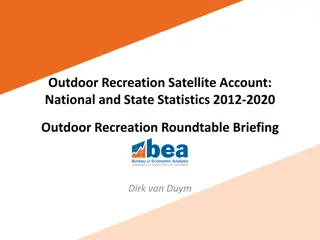TG ax Outdoor Enterprise Scenario and DSC
This presentation delves into the Outdoor Enterprise scenario analysis for IEEE 802.11-15/0804r0, focusing on predictive simulations regarding DSC and various parameters such as antenna heights, transmission powers, LOS constraints, and cell geometry distances. It examines key aspects like free space loss, Fresnel zone, frequency re-use, and signal sensitivities to provide insights into network performance in outdoor enterprise environments.
Download Presentation

Please find below an Image/Link to download the presentation.
The content on the website is provided AS IS for your information and personal use only. It may not be sold, licensed, or shared on other websites without obtaining consent from the author.If you encounter any issues during the download, it is possible that the publisher has removed the file from their server.
You are allowed to download the files provided on this website for personal or commercial use, subject to the condition that they are used lawfully. All files are the property of their respective owners.
The content on the website is provided AS IS for your information and personal use only. It may not be sold, licensed, or shared on other websites without obtaining consent from the author.
E N D
Presentation Transcript
July 2015 doc.: IEEE 802.11-15/0804r0 TG ax Outdoor Enterprise Scenario and DSC Date: 2015-05 Authors: Name Graham Smith Company Address SR Technologies Phone email gsmith@srtrl.com Submission Slide 1 Graham Smith, SR Technologies
July 2015 doc.: IEEE 802.11-15/0804r0 Background Previous presentations have analyzed DSC and the various scenarios: Dense Apartments 13/1487r2, 14/0328r2 Airport capacity 13/1489r5 E_Education 14/0045r2 Enterprise Scenario 15/0548r0 DSC and Roaming 15/0025r0 DSC Practical Usage 14/0779r2 DSC Channel Select and Legacy sharing 14/0294r0 Dynamic Sensitivity Control 13/1012r4, 13/1280r1 This presentation looks at the Outdoor Enterprise scenario. The objective is to predict what the simulations should indicate. Submission Slide 2 Graham Smith, SR Technologies
July 2015 doc.: IEEE 802.11-15/0804r0 Outdoor Enterprise Scenario ????? ???(?(?) < ???) = 22.0log10? + 28 + 20log10??(???) 10 ????? ???? ? > ??? = 40log10(? > ???) + 7.8 18log10 ?? 18log10 ?? + 2log10??(???) 11 9 where the effective antenna height parameters are given by 12 3 8 = ?? 1.0 and ?? ?? = ?? 1.0 and ???=4 ?? ?? ? ?? 4 2 ?(=3 108) ICD 13 19 1 ICD = 130m AP antenna height 10m STA antenna height 1.5m AP TX power 20dBm STA TX power 15dBm 5 7 14 6 18 15 17 16 Submission Slide 3 Graham Smith, SR Technologies
July 2015 doc.: IEEE 802.11-15/0804r0 UMi LOS UMi LOS is very close to free space loss up to the Breakpoint which is related to the Freznel zone. 5GHZ 10m AP Antenna, 1.5m STA antenna, Breakpoint is 312m 1.5m STA Antenna, 1.5m STA antenna, Breakpoint is 17.3m 10m AP Antenna, 10m AP antenna, Breakpoint is 5616m 2.4GHZ 10m AP Antenna, 1.5m STA antenna, Breakpoint is 144m 1.5m STA Antenna, 1.5m STA antenna, Breakpoint is 8m 10m AP Antenna, 10m AP antenna, Breakpoint is 2592m NOTE: No obstruction Losses Submission Slide 4 Graham Smith, SR Technologies
July 2015 doc.: IEEE 802.11-15/0804r0 Cell Geometry Distances Frequency Re-Use 7 AP1 to STA A AP1 to AP1' STA A to STA1 AP1 to STA 1 AP1 to STA2 AP 10 r 4.58r (Closest OBSS AP) 2.646r (Closest OBSS STA/STA) 3.99r (Closest OBSS STA/AP) 5.406r (Furthest OBSS STA) (Furthest STA in BSS) STA B r AP 1 STA 11 STA A Frequency Re-use 3 AP10 to STA B AP10 to AP10' STA B to STA11 AP10 to STA 11 AP10 to STA12 r 3r (Closest OBSS AP) r (Closest OBSS STA/STA) 2r (Closest OBSS STA/AP) 4r (Furthest OBSS STA) (Furthest STA in BSS) AP 10' STA 12 Note: Simulation document uses Frequency re-use of 1 STA 1 AP 1' STA 2 Submission Slide 5 Graham Smith, SR Technologies
July 2015 doc.: IEEE 802.11-15/0804r0 Cell Radius 30m UMi LOS No obstruction losses AP sets DSC Upper Limit to -40dBm DSC Margin 20dB STA B -79dBm from STA A AP 1 -43dBm from AP1 DSC RX Sensitivity set to -63dBm STA A -50dBm from AP1 DSC RX Sensitivity set to -70dBm All STAs within circle Are NOT overlapping with AP1 STA 1 -63dBm from AP 1 -82dBm from STA A AP 1' All STAs outside circle ARE overlapping with AP1 -64dBm from AP 1 STA 2 -67dBm from AP 1 Submission Slide 6 Graham Smith, SR Technologies
July 2015 doc.: IEEE 802.11-15/0804r0 UMi LOS No obstruction losses STA B AP Antenna Height 10m Cell Wall Loss 0dB AP 1 STA A STA 1 AP 1' STA 2 STAs within r/2 of AP 1' do not overlap with AP1 Signal from AP to STA 1 is above the DSC Margin RESULTS with DSC: No STA to STA overlap for cell radius > 12m 70% of STAs will be overlapping with other APs Signal from other APs is only 10dB less than signal from STA at edge of cell Small improvement with DSC RESULTS without DSC: No STA to STA overlap for cell radius > 28m 100% of STAs will be overlapping with other APs All APs are overlapping Submission Slide 7 Graham Smith, SR Technologies
July 2015 doc.: IEEE 802.11-15/0804r0 UMi LOS 3dB cell wall loss STA B AP Antenna Height 10m Cell Wall Loss 3dB AP 1 STA A STA 1 AP 1' STA 2 Some STAs are overlapping with APs for cell radius < 43m ALL STAs are overlapping with APs for cell radius < 31m RESULTS without DSC: STAs will be overlapping with other APs if cell radius <43m All STAs overlapp with APs if cell radius < 31m APs overlap if cell radius <36m Assuming 3dB obstruction loss per cell wall results in perfect 7 CHANNEL REUSE At cell radii > 43m Submission Slide 8 Graham Smith, SR Technologies
July 2015 doc.: IEEE 802.11-15/0804r0 Easily explained by simple body obstructions STA B AP Antenna Height 10m Cell Wall Loss 3dB AP 1 STA A STA 1 AP 1' STA 2 Signal from AP to STA 1 is now under the DSC Margin RESULTS with DSC: NO STAs will be overlapping with other STAs or APs Signal from other APs is ~20dB less than signal from STA at edge of cell (hence easy to set AP threshold) With DSC Assuming 3dB obstruction loss per cell wall results in perfect 7 CHANNEL REUSE NOTE: At ALL cell radii Submission Slide 9 Graham Smith, SR Technologies
July 2015 doc.: IEEE 802.11-15/0804r0 Summary on Frequency Re-Use 7 Using UMi LOS assuming no losses There is no STA to STA overlap at 65m radius for cell radius >12m no DSC, and cell radius >28m with DSC 100% of STAs overlap with other APs with no DSC 70% of STAs overlap with other APs Hence, small advantage with DSC Using UMi LOS assuming 3dB obstruction loss per cell No DSC There is no STA to STA overlap, no DSC STAs overlap with APs if radius <43m APs overlap if cell radius <36m With DSC NO STA overlap with other STAs or APs No AP overlap With DSC can use smaller cells hence higher throughput Fewer STAs competing per cell Perfect frequency reuse 7 for ICD >43m Perfect frequency reuse 7 for ALL ICD Submission Slide 10 Graham Smith, SR Technologies
July 2015 doc.: IEEE 802.11-15/0804r0 Frequency Re-Use 3 UMi no loss Frequency 2.4GHz AP Antenna Height 10m Cell Wall Loss 0dB STA B r AP 1 STA A STA 1 AP 1' STA 2 All AP signals are above the -82dBm CCA threshold RESULTS : 100% of STAs overlapping with all other STAs cell radius < 22m 100% of STAs overlap with at least one other cell 100% of STAs overlap with other APs (5) All APs overlap With DSC Little or no improvement to DL Traffic Improvement for UP traffic With DSC 20% of STAs overlap with STAs in one other cell (STAs closer to AP have higher Threshold) 100% of STAs overlap with other APs (5) APs can be set to not overlap Submission Slide 11 Graham Smith, SR Technologies
July 2015 doc.: IEEE 802.11-15/0804r0 Frequency Re-Use 3 UMi 3dB loss per cell Frequency 2.4GHz AP Antenna Height 10m Cell Wall Loss 3dB STA B r AP 1 STA A STA 1 AP 1' STA 2 RESULTS : STAs overlapping with all other STAs at radius < 30m 100% of STAs overlap with other APs (5) All APs overlap With DSC Improvement with UL traffic for smaller cells Significant improvement to DL traffic With DSC NO STA overlap 50% of STAs overlap with other APs (5) APs can be set to not overlap Submission Slide 12 Graham Smith, SR Technologies
July 2015 doc.: IEEE 802.11-15/0804r0 Summary on Frequency Re-Use 3 Using UMi LOS assuming no losses No DSC 100% overlap of STA to STA with at least one other cell 100% of STAs overlap with APs 100% overlap of APs With DSC 20% of STA to STA with at least one other cell 100% of STAs overlap with APs 100% overlap of APs Using UMi LOS assuming 3dB obstruction loss per cell No DSC 100% overlap of STA to STA for cell radius <30m 100% of STAs overlap with APs 100% overlap of APs With DSC NO STA to STAs overlap 50% of STAs overlap with APs No AP overlap Small advantage with DSC for UL Traffic Some Improvement to UL traffic Significant improvement to DL traffic ALL Cell sizes Submission Slide 13 Graham Smith, SR Technologies
July 2015 doc.: IEEE 802.11-15/0804r0 Conclusions DSC can enable smaller cell radii to be used. Example: Cutting ICD from 130m to 60m will improve throughput by at least 4.7 times Assuming 3dB obstruction loss per cell DSC provides perfect frequency re-use 7 for ALL ICD Without DSC perfect frequency re-use 7 for ICD> 86m DSC provides improvement for re-use 3 for ALL radii Without DSC total STA/AP overlap unless ICD > 130m Conclusion: DSC will show an improvement and if a small obstruction loss is present, dramatic improvement by allowing smaller cells Submission Slide 14 Graham Smith, SR Technologies
